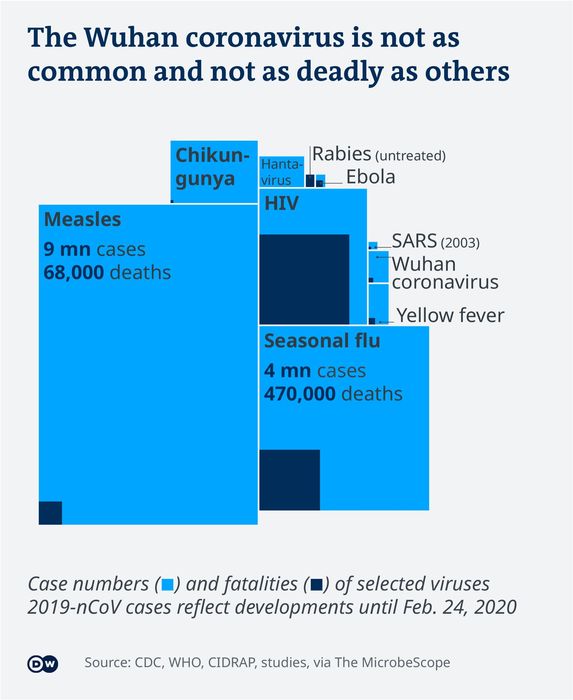Cognitive Lrn&Shr
Latest News / Articles
Coronaviruses are a group of viruses that cause diseases in mammals and birds. In humans, coronaviruses cause respiratory tract infections that are typically mild, such as the common cold, though rarer forms such as SARS, MERS and COVID-19 can be lethal.
Could warmer weather slow the spread of the coronavirus? If all goes well, the new virus SARS-CoV-2, may behave like the influenza virus. Then spring, with its rising temperatures, would kill the pathogens - and stop the spread of the COVID-19 disease. The coronavirus season would pass away just like the annual flu wave, which starts to ebb when winter ends.
Spring may be the season of hope, but it's still too early to say accurately whether SARS-CoV-2 behaves as the influenza virus. Virologist Thomas Pietschmann says, experts can't yet predict the trajectory of the virus because "honestly speaking, we do not know the virus yet."
Pietschmann is a molecular virologist at the Center for Experimental and Clinical Infection Research, called Twincore, in Hanover, Germany. He researches so-called RNA viruses, including for example the hepatitis C virus. SARS-CoV-2 belongs to this group.
According to Pietschmann, "What's special about this virus is that humans are confronted with it for the first time. From the data we have from China, we can conclude that the virus has only once passed from an animal to humans and spread from there" .
Unlike influenza viruses, which nearly everyone has been in contact with at some point, our immune system is not prepared for an attack with corona pathogens.

Source : CDC,WHO,CIDRAP, studies
Pietschmann mentioned, In addition, the external conditions in the northern hemisphere are currently virtually perfect for the rapid spread of the virus. For one thing, there's the temperature. Respiratory viruses, i.e. those that spread via the respiratory tract, have a particularly easy time when the weather is cool. "Viruses have greater stability at low temperatures. This is similar to food that keeps longest in the refrigerator" .
The warmer it gets, the more difficult the conditions are for many viruses. "The coronavirus is surrounded by a lipid layer, in other words, a layer of fat," Pietschmann explains. This layer is not very heat-resistant, which means that the virus quickly breaks down when temperatures rise. "Other viruses, such as the norovirus, are more stable because they consist mainly of proteins and genetic material."
Pietschmann also mentioned , For other pathogens, temperature only plays a subordinate role. The dengue virus, for example, is mainly found in tropical and subtropical regions. But this has less to do with the pathogens liking warm weather: "In this case, it is not the temperature that plays the main role in the spread of the pathogens, but the animal that transmits the virus" .
Pietschmann elaborated, Air humidity also influences the transmissibility of respiratory viruses. Once the pathogens have been expelled from the respiratory tract with a strong sneeze, they literally hang in the air. "On cold and usually dry winter days, the small droplets, together with the viruses, float in the air longer than when the air humidity is high" .
In this way, the pathogens can spread rapidly. However, at first they do this quietly and secretly. From the first contact with the pathogens to the first symptoms of the disease, several weeks can pass. The length of this incubation period depends on the characteristics and biology of the virus.
Fever, pain and chills are typical symptoms of a viral disease and a sign that the body is fighting off the invaders. How successful this fight is depends not only on the age and health of the infected person, but on his or her gender. In the case of the coronavirus, the data shows that women have higher survival chances than men. At 2.8%, the mortality rate of men is significantly higher than that of women, at 1.7%.
According to Pietschmann, this difference can be explained by genetics. "Some immune-relevant genes, for example genes that are responsible for recognizing pathogens, are encoded on the X chromosome. Because women have two X chromosomes and men have only one, the female sex has an advantage here."
The female hormone estrogen also helps women fend of viral diseases. "Some immune-relevant genes also have binding sites for estrogens, where these genes are switched on. This means that these genes are also controlled by the hormones," says Pietschmann.
Perhaps the corona season will indeed end with the beginning of spring in the northern hemisphere. According to the World Health Organization (WHO), however, there are more than 20 cases of SARS-CoV-2 in Australia and one case in Brazil - in the southern hemisphere. Where winter is yet to come.
Share This:
Read all Latest Online Learning Resources News
Source: www.dw.com
Copyright © 2018 Cognitive Lrn&Shr . all rights reserved.